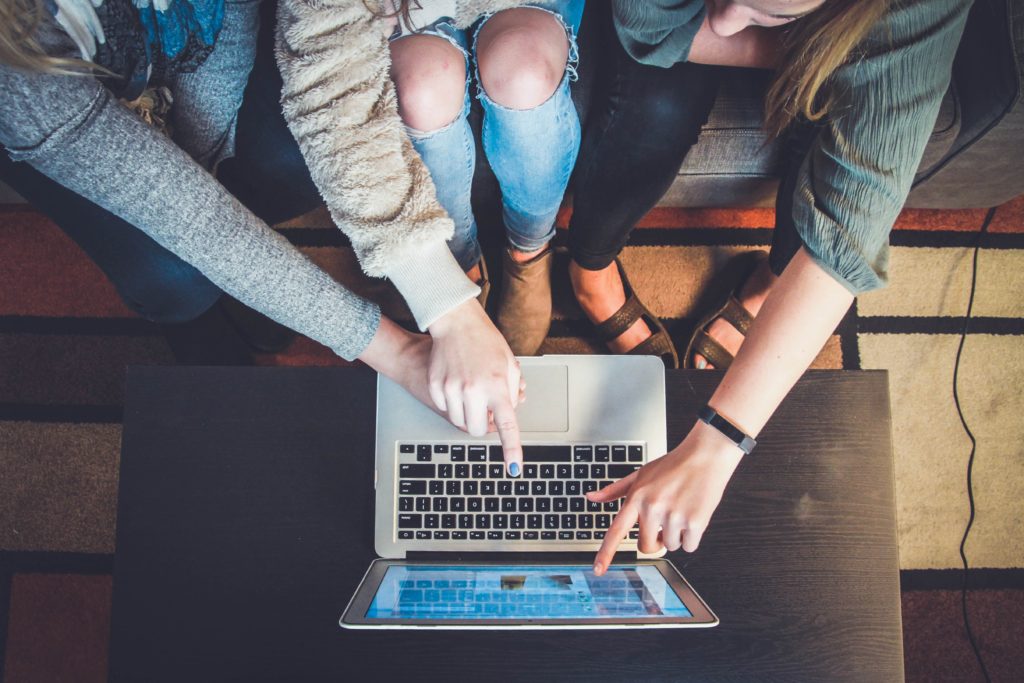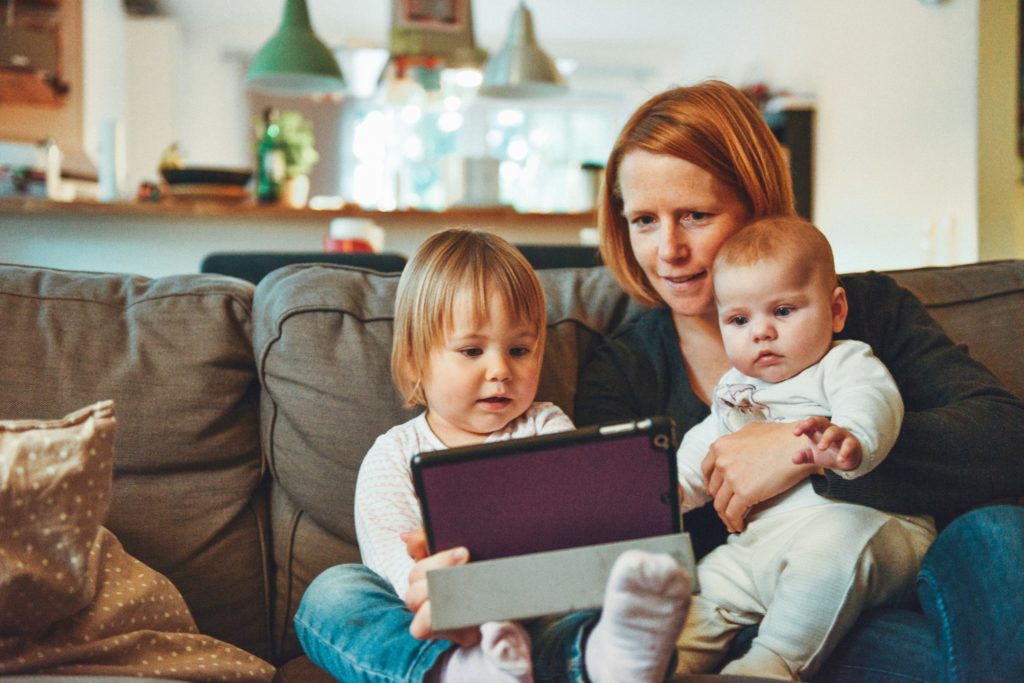
In this second installment of my Culture Matters: Kids & Tech series, I will outline my family’s tech policy along with detailing each family member’s individual tech use and ownership. Additionally, I will offer age-appropriate rules and internet safety guidelines for your family’s personal consideration.
If you have any rules, recommendations or resource referrals that I have not mentioned in this article or in my previous technology-related article, please do not hesitate to share them with me! I love learning how other parents are raising the next generation of safe-tech, screen-smart, image bearers 🙂

Social Media Use:
Kids
- My children (ages: 5, 3, and 1) do not have their own social media accounts.
- My children (ages: 8 and 11) use Facebook Messenger Kids, which is set up with parental controls and linked to a parent’s Facebook account. These children have very limited access to Facebook Messenger and have to “work” to earn 5 minutes of use, such as doing their homework, chores, good behavior, etc.
- My husband and I will not allow any of our children to have any personal social media accounts until they reach high school and have demonstrated both a high level of maturity and responsibility (over the years preceding). At that time, my husband and I plan to evaluate all of the current social media platforms and will decide which ones, if any, we will allow that individual child access to. Presently, I am very concerned with the factual data that negatively documents various risks, dangers, and side-effects associated with regular or on-going social media use (such as bullying, poor mental health, child grooming, addiction, low self-esteem, increased narcissism, and so much more).
- If/when my child comes of age to have a social media account,* I am sure my husband and I will instill a rule of allowing parental consent to review all content, communication and followership. We will also require our child(ren) to have a private account that accepts followership of my husband and/or myself along with access to a known or shared password.
As one of my favorite parent advocates, Arlene Pellicane, says, if a child has to go through (and pass!) a driver’s training course before receiving their driver’s license, then it would be wise for a child to prove the same type of training and responsibility prior to receiving a smartphone and/or social media.
Parents
- My husband and I share a Facebook account
- My husband currently has LinkedIn, Telegram, Twitter and Instagram accounts
- I have Instagram and Pinterest accounts
- I do not receive social media notifications on my phone screen or via email
- I try to limit my social media use to no more than one hour per day. I also adopted the habit of “No Social Sunday” several years ago as a way to not access social media on the Sabbath.
- I cannot speak to my husband’s personal social media use, but I do know he is fond of Twitter in his rare and spare moments between being a dad, husband and business owner 😉

Personal tech “ownership:”
- My husband and I both have iPhones
- We share a laptop
- My husband has a tablet
- Our family has one desktop computer that is in our home office (located on the main level of our home)
As my kids get older, I am sure we will be adding more laptops to our supply, but we hope to hold off on that for as long as possible. One thing is for sure – we do not allow our children to bring technology (including TVs) into their bedroom, bathroom or behind any closed doors (unfortunately, this was how I learned about some of the porn-exposure incidences). I think it is best to keep all technology out in the open or in a space where you can keep tabs on what your child (or anyone, for that matter!) is accessing or viewing.
My oldest daughter (11):
She received an iPod for her 10th birthday after spending a full year proving her maturity and responsibility (to my husband and me). Yes, they do still make iPods(!), but Apple is phasing them out. We decided to go the iPod route because it is more parental controllable, yet it also looks like an iPhone, so my daughter’s friends don’t know the difference. iPods were initially developed to play and store music and that is still the primary function of them, however, iPods now offer text, Facetime and voice call capability when connected to Wi-Fi. This was a big selling point to us because she can text and call her friends and us, but we don’t have to pay for another phone account. The negative, of course, is we can only communicate with her when she is connected to Wi-Fi.
Our rules and guidelines (for our 11-year-old’s iPod “ownership”) are:
- She is allowed a maximum of one hour of use per day (she rarely uses a full hour; there is also an alert she receives as her time accumulates and an automatic shut-down of the device at 9pm)
- She is never allowed to disclose her physical location to anyone other than her parents (likewise, she is never allowed to “tag” or “pin” her location unless her parent tells her to)
- She has to store and charge her iPod in our bedroom every night
- She has to “okay” all new contacts or age-appropriate apps with us (she is currently only able to access apps rated for 12+ years and we receive a notification for all app inquiries prior to download)
- She acknowledges her parents are able to scroll through her device at any time to examine her communication and activity. We also know her password.
We have had a good experience with the iPod thus far and it has been an effective, natural progression of personal technology use and “ownership.”
My second daughter (8):
She received the original Verizon Gizmo Watch about a year ago. This was a hand-me-down from my eldest, but it still works and serves the function of being able to call (and receive calls from) a four pre-stored phone numbers. There is also an app connected to the Gizmo that allows a parent or guardian the ability to track where the watch is at all times. Over the last few years, I have seen a few other providers come out with watches similar – I think this is a great option for a child who is seeking more independence and responsibility while also offering parents or guardians the opportunity to contact their child when needed or to monitor their child’s physical location when desired.
For her 8th birthday this summer she received the newest addition of the Gizmo Watch which is a HUGE upgrade! The latest version has a lot of the same features as the original but also acts as a watch that tells time, has texting capability and can communicate with up to nine parent-approved (and parent-programmed) phone numbers.
(Monthly service plans are available through Verizon)
My son (5):
He was gifted a Nintendo Switch for his 4th birthday. Obviously, he loved it, a little too much for my liking. After a good month of using it (on average, 30-minutes a day), I could sense he was developing an addiction to it, so I told my husband we either need to ground him for bad behavior resulting from game use or we need to further limit his use.
As it turned out, his Switch broke…right at the start of the Covid-19 pandemic. Nintendo was unable to fix it (due to the pandemic) for nearly 9 months! My son “survived” both home school with me(!) and the pandemic without any video games. (In the beginning of the pandemic, I bet he thought both were impossible!)
He has since received his Switch back, but he hasn’t been nearly as attached to it as he briefly was when he first received it. (The Switch is his only personal tech item at this time.) In mama’s eyes, an addiction crisis has been averted! Still, be mindful for not just tech addiction but also gaming addiction – they are both real, damaging and preventable.
My younger children (3, 1) do not “own” any personal technology devices at this time. They have had restricted technology exposure and have logged way less hours on technological devices than the siblings before them. After parenting for over a decade, you could say I have learned some valuable lessons 😉

Other parental considerations for technology use:
- Discuss specific limitations, rules, or guidelines for your child’s tech use and exposure outside of the home, such as at a friend’s house, with grandparents, while riding the bus to school or while at school, during sleepovers, at the doctor’s office, extracurriculars, etc.
- Make certain places “tech-free” zones, like during meal-time, while riding in the car, at family gatherings, or in bedrooms or bathrooms.
- Have children “earn” screen time minutes or “work” to receive a device.
- Preview and/or research all apps, websites, games, and social media platforms prior to granting access to them. (I’m telling ya, friend! This is SO IMPORTANT!)
- Consider implementing some type of “tech jail” box where you hold devices hostage so individuals are not distracted from verbally and physically interacting with one another. It could also be used as a place to lock away devices at night or if family rules or guidelines have been violated.
- “Caving in” to screen time, social media accounts, device “ownership” or other because so-and-so does something or has something is never a valid reason to submit. Remember that you are the parent and your child is the child. You know better so you can do better. If you desire to raise responsible, independent, and hardworking adults, then you must do the hard work of researching, restricting, disciplining and discipling. Like all things good, it takes time, effort and energy but the return on investment is always worth it!
*Personally, I think social media is more destructive than it is uplifting and would prefer for my children to never be on it. Even for my own self, I have a hard time discerning and navigating away from negative or toxic posts, accounts, platforms, or conversations. FOMO, increased selfishness and development of a narcissist personality, addiction (with use, scrolling, posting, followership, affirmation, etc.), pressure to conform, comparison and more, are all real side-effects of social media use in addition to the other examples I mentioned earlier in this article.
**The purpose of this editorial is to promote conversation, contemplation and consideration for a specific issue that is relevant in today’s culture. All of the information provided should be used as an introduction or starting point that guides the reader to personal research, reflection and discovery. All of the thoughts, opinions, experiences and recommendations mentioned in this article are the author’s own.